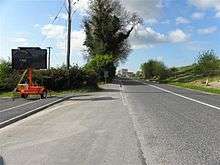Gortawee

Gortawee (also called Scotchtown) is a townland in the Parish of Tomregan, Barony of Tullyhaw, County Cavan, Ireland.
Etymology
The townland name is an anglicisation of the Gaelic placename “Gort Aodh Bhuide” which means ‘Hugh Boy’s Field’. The oldest surviving mention of the name is in the 1609 Ulster Plantation map where it is spelled as ‘Gortewey’. Its modern name ‘Scotchtown’ is supposedly derived from some Scottish soldiers who settled there.
Geography
It is bounded on the north by Aughrim townland and by the international border with Fermanagh and Northern Ireland, on the east by Annagh townland, on the south by Rakeelan townland and on the west by Mucklagh townland. Its chief geographical features are the Shannon-Erne Waterway which flows north along its eastern boundary, some tree plantations and a foothill of Slieve Rushen mountain reaching to 203 feet (62 m) above sea-level.
Gortawee is traversed by the regional R205 road (Ireland), Aughrim lane and Featherbed lane.
The townland covers 135 statute acres, including 1-acre (4,000 m2) of water.
History
It formed part of the Manor of Calva which was granted to Walter Talbot in 1610 as part of the Plantation of Ulster. The Hearth Money Rolls of 1664 list the occupiers of Scotstown as John Gilmur, Cohonatt O’Skallon and Patricke O’Scallon.
The Tithe Applotment Books for 1827 list the following tithepayers in the townland- Mitten, Reilly, Fitzsimons, Bedell, Curry.[1]
The Ordnance Survey Name Books for 1836 give the following description of the townland- "Gort Aodha Bhuídhe, 'Hugh Boy's field'. North-east of parish. Property of Montgomery. Rent 16 shillings to £1 per arable acre. Gravelly soil. 16 acres of pasture. A road passes through it. The tenants are poor farmers."
The 1841 Census of Ireland gives a population of 66 in Gortawee, of which 30 were males and 36 were females, with 10 houses.
The 1851 Census of Ireland gives a population of 27, a decrease of 39 on the 1841 figure, due to the intervening Irish Famine of 1845–47, of which 11 were males and 16 were females, with 4 houses.
Griffith's Valuation of 1857 lists the landlords of the townland as Benson and Reilly & the tenants as Fitzsimons, Maguire, Reilly, Fee, McAvenue, Foster, Baxter, Elliott, Curry, Benson and Roe.[2]
In the 1901 census of Ireland, there are twelve families listed in the townland.[3]
In the 1911 census of Ireland, there are twelve families listed in the townland.[4]
In the Dúchas Schools' Collection at http://www.duchas.ie/en/cbes/5083770/5039629 is a description of Scotchstown in 1938 by John McKiernan.
Antiquities
The only historic sites in the townland are Slieve Russell House.[5] and the Border Crossing checkpoint.
